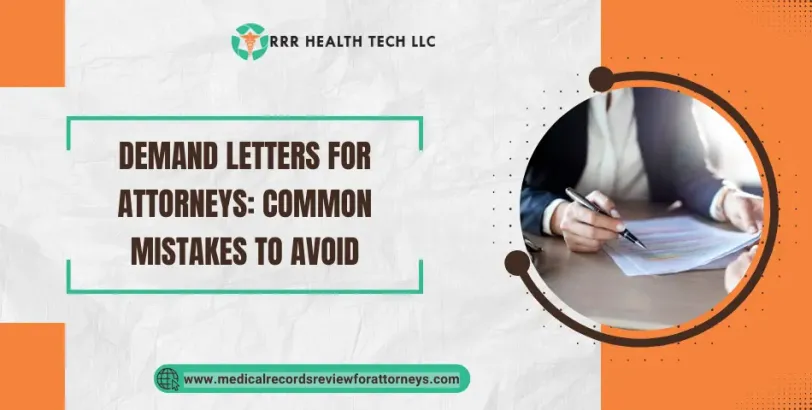
Demand letters often serve as some of the most critical communication documents in fostering conflicts, especially in personal injury, insurance, and other civil litigation cases. They can also impact the tone of a case and often dictate its outcome altogether. However, most attorneys overlook these letters’ importance by making “lesser” mistakes, resulting in lost chances, prolonged processes, and lower payouts, and drafting demand letters.
This blog investigates what those mistakes are while highlighting the need for outsourcing of demand letters to ensure optimized outcomes.
Understanding Demand Letters for Attorneys
Demand letters are easily one of the most cited examples of a negotiable document. A demand letter is simply a request that one party sends to another, which comes with stipulations that range from a request for payment, action, payment resolution, or an entire lawsuit.
Demand letters empower people who require legal assistance for anything in personal injury, medical malpractice, or have employer disputes, or even insurance disagreements.
Demand letters aim to:
- Notice of the relevant issue.
- Claim includes a legal and factual basis.
- State claim without wage or capital destruction.
- Substantial proof before court proceedings.
And owing to all the risks it poses; precision and legal expertise must underpin every aspect of the demand letter.
Key Components of an Effective Demand Letter
An effective and professionally written demand letter includes:
- Professional and polite tone
- Clear facts
- Relevant documents like medical reports
- Legal basis for the demand
- What is being demanded (monetary payment, action, or stopping behavior)
- Timeline for response
- Non-compliance consequences
Using legal medical demand letters within personal injury claims also requires exact alignment of medical proof to injuries claimed, which can be a complex and tedious chore for attorneys.
Common Mistakes to Avoid When Drafting Demand Letters
Lack of Clarity and Focus
Loosely structured demand letters separated by paragraphs with vague flow often add jargon terms do little to nothing to legally bind a case together and must serve to stand front and center, shedding light on informative focal points relating to and forming the epicenter, either stemming from facts or law, for bullet demands through a letter.
Insufficient Evidence
Leaving documents such as medical documents in a demand letter, for example, not collecting strongly persuasive evidence, reduces the trust factor in a claim for the medical towards the letter.
Overlooking Key Facts
Leaving important details out, such as incidents or omitted losses, can create disputes while negotiating. Accuracy is crucial with demand letters.
Aggressive or Unprofessional Tone
Firm language is useful, but overdoing it makes the sender appear unreasonable, which ends up harming negotiations down the road.
Inconsistent Formatting and Structure
Amid unprofessional business practices noted in the writing of demand letters, incorrect letter formatting and styles of address tend to be overlooked. The unprofessional design, coupled with the misspelled recipient’s name, invalidates the demand letter.
Legal Formalities Often Overlooked in Demand Letters for Attorneys
At times, even lawyers of considerable experience forget to:
- Add legal references
- Include relevant geographical parameters
- Maintain confidentiality of the client
- Comply with deadline obligations
These simple formalities, when skipped, diminish the overall impact of legal demand letters and significantly reduce their effectiveness.
The Importance of Professionalism and Clarity in Demand Letters
A preview glance at an attorney’s desk indicates the demeanor that is bound to be used; this encompasses more than the tone. Everything measurable is grammar, format, and the legal constitution, portraying the professionalism of the writer.
In this way, a case-winning demand letter must be:
- Unambiguous in objective
- Exact in the evidence presented
- Arranged through the reasoning of the claim that leads a reader to follow the flow
There is a rising demand not only for law professionals, but for time-efficient legal professionals who limit the timeline of demand letters. These advanced, always sought-after, hassle-free resources (subcontracting) are optimal for overworked legal aid.
Follow-Up Strategies After Sending a Demand Letter
The need to follow up is equally critical for sending the document. This is done best by:
- Planning reminder messages on deadlines for at least getting a reply.
- Courteously issuing friendly reminders or over further escalations.
- Starting a response to begin negotiations or mediations.
Prompt responses portray a sense of inconsistency while actively retaining the claim; a timely follow-up can greatly adjust the amount of time it takes to resolve legal matters.
Conclusion
Steering clear of common pitfalls, such as drafting demand letters, will save practitioners time and polish their legal communication, but will also, essentially, optimize results. Whether personal injury demand letters, demand for disputes with insurance, or other civic claims, having proficient guidance eases the mind and directs to the expert’s mastery.
Outsourcing demand letters is an efficient approach toward saving money while ensuring quality that is consistent, convincing, and competent, legally as well as better positioned in terms of the law
Need Help Crafting Professional Demand Letters?
Attorneys have access to tailor-made high quality demand letter drafting services at RRR Health Tech. Our advantages include:
- Economically friendly
- Prompt execution
- Legally verified
- Professional Medical & Legal Experts to Back Us
Receive your case-winning demand letters with the accuracy, speed, and legal impact that you need.
